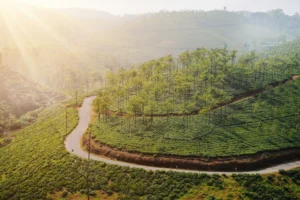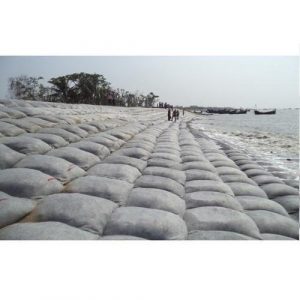Strength Beneath the Surface: Geotextile Excellence at Leh Airport by Ocean Non Wovens
Introduction
Nestled in the high-altitude desert of northern India, Leh in Ladakh is one of the most logistically challenging regions in the country. With freezing temperatures, rugged terrains, and limited oxygen, building and maintaining infrastructure in Leh is an engineering feat in itself. When the need arose to enhance the structural integrity and longevity of airport infrastructure in this region, the solution had to be both technically sound and resilient to harsh environmental conditions.
Ocean Non Wovens had the opportunity to contribute to this vital infrastructure project by supplying and installing 2,400 square meters of Non Woven Geotextile 200 GSM for the Leh Airport project. Our advanced geosynthetic solution played a crucial role in improving the subgrade stabilization and drainage, ensuring a safer and longer-lasting runway and taxiway surface.
Table of Contents
The Role of Geosynthetics in Airport Construction
Modern airport construction increasingly relies on geosynthetics to improve performance, reduce maintenance, and extend the life cycle of pavements and runways. According to a report published by the International Geosynthetics Society (IGS), geotextiles are widely used in runway construction for applications like separation, filtration, reinforcement, and drainage [1].
Runways and taxiways must withstand repeated heavy aircraft loads and prevent differential settlement, especially in remote or high-altitude locations like Leh. Geosynthetics like non-woven geotextiles provide the underlying strength required to maintain pavement performance in such conditions.
Challenges of the Leh Region
Constructing airport infrastructure in Leh is uniquely complex due to:
- Permafrost and Soil Instability: The region experiences ground freezing, which can expand and contract, leading to surface cracks and destabilization.
- Limited Construction Window: Due to snowfall and sub-zero temperatures, work is often limited to a few months in a year.
- Remote Access: Transporting materials requires strategic logistical planning, often involving long travel times and high altitudes.
Understanding these conditions, we recommended our 200 GSM Non Woven Geotextile, known for its mechanical strength, permeability, and ability to handle harsh climates.
Why 200 GSM Non Woven Geotextile?
Ocean Non Wovens’ 200 GSM Non Woven Geotextile is manufactured using high-quality polypropylene fibers that are needle-punched for durability. It offers a perfect balance between mechanical strength and hydraulic functionality. Key benefits include:
- Separation and Stabilization: Prevents intermixing of subgrade and aggregate layers, essential for runway durability.
- Drainage Capability: Allows water to pass while filtering out fines, reducing waterlogging and freeze-thaw cycles.
- Flexibility in Extreme Weather: Remains structurally stable even under severe cold, making it ideal for Leh’s temperature extremes.
- Long-Term Performance: Resists biological and chemical degradation, providing decades of service life [2].
Execution and Installation
The installation process required precise coordination due to the limited availability of daylight and workforce acclimatization challenges. Our engineering team worked closely with the on-site contractors to ensure that the geotextile was laid uniformly with proper overlaps, anchoring, and protective layering. Each section was meticulously inspected to avoid wrinkles or gaps, which can lead to structural failures over time.
Despite the altitude and logistical constraints, our team completed the delivery and deployment efficiently, showcasing our ability to operate in difficult terrains without compromising on quality.
Insights Most Companies Don’t Share
While most suppliers speak about product delivery and installation, very few highlight the pre-installation groundwork that is essential in high-altitude zones like Leh.
- Acclimatization Protocols: Our field team followed a mandatory acclimatization routine to adapt to Leh’s high elevation (3,500+ meters), ensuring safety and productivity.
- Material Handling Practices: To avoid brittleness of geotextiles in sub-zero temperatures, materials were temporarily stored in insulated shelters before deployment.
- Environmental Compliance: We ensured zero disturbance to the natural surroundings by using eco-friendly packaging and adhering to waste disposal guidelines.
These practices underscore our commitment not just to engineering but also to responsible environmental conduct.
Conclusion: Building Runways That Last
The Leh Airport project stands as a testament to how advanced geosynthetics can solve real-world infrastructural challenges. Ocean Non Wovens is proud to have played a role in strengthening India’s aviation backbone in one of its most demanding locations.
Our 200 GSM Non Woven Geotextile proved to be the optimal solution for this project, ensuring separation, drainage, and subgrade stabilization that will withstand decades of wear and climate stress.
Why Choose Ocean Non Wovens?
As a leading manufacturer and supplier of geosynthetics in India, Ocean Non Wovens combines world-class product quality with on-ground expertise. Whether it’s a remote airfield in Ladakh or a mega urban infrastructure project, we deliver tailor-made solutions backed by engineering excellence, prompt service, and environmental responsibility.
Get in touch today to learn how our geosynthetics can reinforce your next project from the ground up.
References:
[1] International Geosynthetics Society (IGS) – Applications of Geotextiles in Transportation
[2] Koerner, R. M. (2012). Designing with Geosynthetics, 6th Edition



